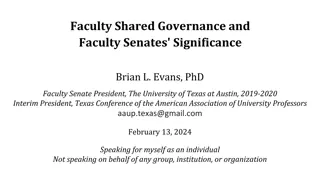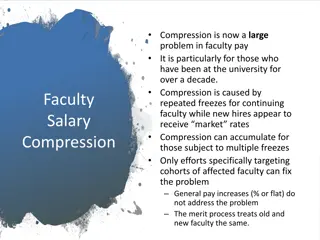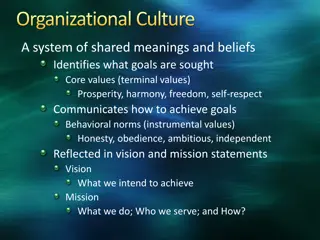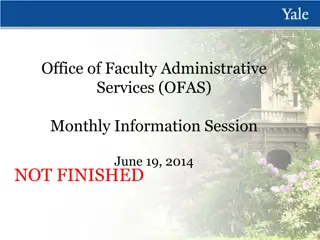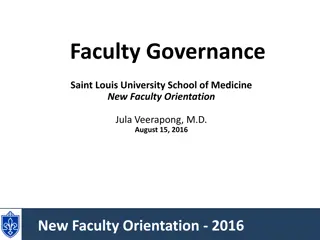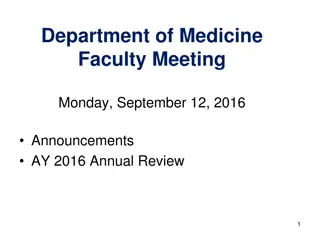
The Role Department Culture Plays in Acclimating New Faculty
Discover the impact of department culture on new faculty acclimation and how a strong culture can benefit organizations. Learn why department culture matters, its definition, and the benefits it brings. Explore how fostering a positive culture can support new faculty members and enhance the overall institution.
Uploaded on | 0 Views
Download Presentation

Please find below an Image/Link to download the presentation.
The content on the website is provided AS IS for your information and personal use only. It may not be sold, licensed, or shared on other websites without obtaining consent from the author. If you encounter any issues during the download, it is possible that the publisher has removed the file from their server.
You are allowed to download the files provided on this website for personal or commercial use, subject to the condition that they are used lawfully. All files are the property of their respective owners.
The content on the website is provided AS IS for your information and personal use only. It may not be sold, licensed, or shared on other websites without obtaining consent from the author.
E N D
Presentation Transcript
The Role Department Culture Plays In Acclimating New Faculty March 2nd, 2022
Focus The organization and departments can impact new faculty either positively or negatively. A uniform guideline for hiring new faculty can help the transition of new faculty into our institution and into a department.
Why? I picked this topic due to my experience of being a new hire at our institution. Even though I had great training and support at the beginning of my hire into NLU, I believe we can improve our practices to help our new faculty transition better into our institution. This will not just help the new faculty member, but also help the departments, our institution, and our students.
What Is Department Culture? The culture of a group can now be defined as a pattern of shared basic assumptions that was learned by a group as it solved its problems of external adaptation and internal integration, that has worked well enough to be considered valid and, therefore, to be taught to new members as the correct way to perceive, think, and feel in relation to those problems. (Schein, 2004, p. 17).
Department Culture Each organization has its own culture. UGC has its own culture, each department has a unique culture and so do each of our classrooms. For an example, I can speak on our math department s culture. We value each other s experiences, credentials, points of views, feelings, and cultures. We work well together and if any of us are in need of support, we can count on the other members of our group to help.
Benefits of having strong dept culture/organization culture Culture adds critical elements to a group (Schein, 2004, pp.14-15): 1. Structural stability 2. Depth 3. Breadth 4. Integration The benefits of these characteristics is as a group we share a sense of values, beliefs and strategies. Each point of view the group shares, measures the depth of the group. The shared point of view (level of depth) provides a level of stability in the group. Structural stability increases when more points of views, feelings and values are shared in a group. These shared values, point of views, and feelings alter how each deals with primary tasks at hand. Working together as a group fosters unison. This is called appreciative inquiry
Why Does It Matter? Newcomers may experience a sense of disorientation or foreignness, and a kind of sensory overload described by Hughes (1958) as "reality shock." In this perspective, socialization as an adaptive process can either support or confuse the individual learning a new role (Rosch & Reich, 1996) If we introduce the new faculty in ways that help maintain/improve the culture of the organization and/or department, this will help the following: Ease transitioning of new faculty into new job position Increase productivity Become more familiar with the organization culture More familiar with department culture More familiar with students needs Become more creative in their new position
Acclimating Once Hired Faculty candidates select information during the hiring period, process this information, and formulate preconceptions regarding the new setting using predispositions (professional values and role disposition) as a frame of reference (Rosch & Reich,1996) So, how should we introduce new faculty into a department to help ease their transition into their new roles in NLU? Please share your thoughts on this question in this Google Jamboard link below. Link
Ways of Introducing New Faculty Into Department Culture For new faculty to acclimate into the culture of UGC and in the department, the new faculty needs to learn the aspects of culture from UGC and from the corresponding department that they belong to (Schein, 2004). There should be an obvious awareness of alignment between UGC and department Inside Higher Ed suggest the department should be transparent about the department climate and culture (https://www.insidehighered.com/advice/2019/07/23/advice-academic- administrators-helping-new-faculty-members-acclimate-opinion).
Ways of Introducing New Faculty Into Department Culture Introduce faculty into department after being hired via email and in- person Introducing the new faculty into the department helps new faculty become familiar with the social environment of the department Effective interaction between newcomers and organizational members is paramount to successful socialization (Cawyer, Simonds, & Davis, 2002, p. 228). This introduction could also foster an environment of inclusion. Acclimating faculty into the department can also help acclimate them into the organization.
Ways of Introducing New Faculty Into Department Culture Provide new faculty orientation/training Have monthly meetings with the new faculty and their department chair Provide the new faculty with a checklist. A website was created for new faculty at NLU. This is the link: https://nl.edu/ctle/managing-your-course/new-faculty-start-here/ Provide information and responsibilities in increments, giving the faculty time to acclimate into the institution through climate, culture, students, and teaching. This will help the new faculty decrease or eliminate the feeling of being overwhelmed with too much information at the start of the position.
Ways of Introducing New Faculty Into Department Culture Partnering new faculty with a mentor. This will help acclimate the new faculty into the department and into an institution Also this will help facilitate the understanding of students needs Mentors helps new faculty to become successful in their career. (Perry, Dean, & Hilton, 2019) Perry, Dean, & Hilton (2019) suggests using a mentoring program for new faculty. It is best to create a program that would address specific and long-term needs of the faculty member (Garrison, 2005, p.8) A website was created for new faculty at NLU. This is the link: https://nl.edu/ctle/ctle-programming/peer-to-peer-learning-opportunities/
Conclusion Work culture plays a large role in the workplace. Every organization, department, and classroom have a unique culture. It is important to keep that in mind when we are introducing new faculty into our institution. I am suggesting we have more uniform guidelines for hiring new faculty. This way the new faculty and staff are familiar with the organization and departments culture. This will help the departments become more familiar with the new faculty. Additionally, this will help the new faculty ease into their new position. Uniform guidelines for hiring new faculty will result in a more positive experience for the new faculty and their corresponding department. Plus, it will help increase students success.
References Perry, A., Dean, S., Hilton, A. (2019). New Faculty Transitions and Obstacles: An Auto- Ethnographic Exploration. Journal of the Professoriate. (10)2, 43-72 Prof, Junior. (2019, July 23). How to Help New Hires. Inside Higher Ed. https://www.insidehighered.com/advice/2019/07/23/advice-academic-administrators-helping-new- faculty-members-acclimate-opinion Reich, J. N. (1996). The enculturation of new faculty in higher education: A comparative investigation of three academic departments. Research in Higher Education, 37(1), 115-131. Schein, Edgar. (2004). Organizational Culture and Leadership. John Wiley & Sons, Inc. , 1-437 Garrison, C. (2005). Exploring New Faculty Orientation: The Good, The Bad, and Making it Better. Essays in Education. 13(6), 1-9 Cawyer, C. S., Simonds, C., & Davis, S. (2002). Mentoring to facilitate socialization: The case of the new faculty member. International Journal of Qualitative Studies in Education, 15(2), 225-242.\

